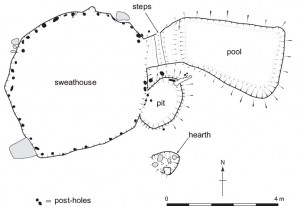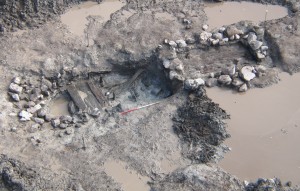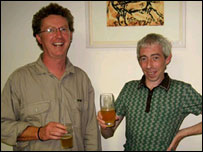The Great Beer Experiment produced a passable ale, but the proof of the pudding is not just in the drinking. The strength of an experimental hypothesis is underpinned by what we find in the dirt; if there is a general lack of animal bone to support O’Kelly’s cooking explanation, the archaeobotanical evidence to support the brewing interpretation is equally sparse.
Heading their detractors off at the pass, Quinn and Moore argued that spent grain would not have been disposed of by prehistoric brewers, as it was still nutritious. Even after mashing in the trough, the grain could have been recycled to make bread, or given to animals as fodder. The by-product from the brewing process would also have been extremely vulnerable to microbacterial decay. Grain identified on archaeological sites has usually been charred during cooking or drying, but this would not have been used in brewing, as it would have spoiled the beer mash. Even if botanical remains from brewing at burnt mounds had survived, they would not have lasted long before being consumed by animals, birds and vermin.
We may also expect to find the tools associated with brewing at burnt mounds, and in this regard archaeologists have been more successful. At Ballyduff East, near Waterford, Linda Hegarty discovered a saddle quern and rubbing stone deposited in a burnt mound trough. The first stage of the brewing process would have required the barley to be malted by artificially germinating the cereal grains – placing them in a container in running water, then halting the process by drying with hot air. The malted cereal would then have been ready for grinding. By placing a handful of grains in the centre of the saddle quern, the rubbing stone was pushed back and forth to produce a rough-milled malt ready for the mash.
The Sauna Hypothesis
 Luxury spas are the current height of modern hedonism; a day spent at the spa is an escape from the trials and tribulations of everyday life. It may come as a surprise that some archaeologists think that burnt mounds represent their Bronze Age counterparts.
Luxury spas are the current height of modern hedonism; a day spent at the spa is an escape from the trials and tribulations of everyday life. It may come as a surprise that some archaeologists think that burnt mounds represent their Bronze Age counterparts.
Lawrence Barfield and Mike Hodder developed the ‘sauna hypothesis’ to explain a series of burnt mounds they excavated in the Birmingham area. Sweathouses are a consistent feature in many cultures in the northern latitudes, with the Finnish sauna being the best known. Drawing on ethnographic parallels with Native American Indian sweat-lodges, they also used experimental archaeology to demonstrate the viability of their theory.
Recent excavation work in Ireland has identified exceptionally well-preserved burnt mounds with clear evidence for associated ‘sweat-lodge’ structures. Liam McKinstry recently excavated a Bronze Age ‘bath house’ at Annaholty, Co. Tipperary, and Caitriona Gleeson found the clearest example thus far excavated of a sweat-lodge at Rathpatrick in Co. Kilkenny, both for Headland Archaeology (Ireland) Ltd (See Illustration).
 The main feature at Rathpatrick was a 5m diameter circular structure with a sunken floor. Thirty-six stake-holes were found regularly spaced around the periphery, interpreted as supporting a hemispherical, tent-like covering (hazel charcoal had been recovered from the stake-holes – an ideal wood for bending). The excavators suggested hot stones had been heated on an adjacent hearth and then rolled into a pit within the sweathouse. If water had been sprinkled on theses stones, it would have made an effective sauna. Once the occupants had enjoyed their sauna, two steps led out of the structure into an outside ‘plunge-pool’ where they could cool down.
The main feature at Rathpatrick was a 5m diameter circular structure with a sunken floor. Thirty-six stake-holes were found regularly spaced around the periphery, interpreted as supporting a hemispherical, tent-like covering (hazel charcoal had been recovered from the stake-holes – an ideal wood for bending). The excavators suggested hot stones had been heated on an adjacent hearth and then rolled into a pit within the sweathouse. If water had been sprinkled on theses stones, it would have made an effective sauna. Once the occupants had enjoyed their sauna, two steps led out of the structure into an outside ‘plunge-pool’ where they could cool down.
These sites may not be representative of all burnt mounds, but they do show that many had much more complex functions than simply as cooking sites. Neither were they solely used for personal hygiene. Sweat-lodges are known ethnographically to be involved in complex rituals relating to rites of passage, such as birth and death, and are a powerful tool for attaining altered states of consciousness.
Past Orders
Rather than solve the problem of burnt mounds, Quinn and Moore’s experiment stimulated yet another round of discussion. Zooarchaeologist Auli Tourunen published an assessment of all the burnt mound evidence from a series of sites excavated on the N9/N10 Carlow Bypass. From 18 burnt mounds, a rigorous sampling strategy by Headland Archaeology (Ireland) Ltd recovered 1,346 pieces of animal bone, predominantly cattle. The anatomical distribution of these bones was consistent with primary butchery waste, suggesting that meat was processed, but not consumed, on site.
 Other archaeologists have been quick to defend their own pet theories, and good evidence for both the sweat lodge and textile interpretation have recently come to light. With further research, we may be able to classify a number of types of burnt mound that represent a number of different functions, all based on the same hot stone technology. The Great Beer Experiment might not be the only explanation for all burnt mounds, but it is certainly the most enjoyable.
Other archaeologists have been quick to defend their own pet theories, and good evidence for both the sweat lodge and textile interpretation have recently come to light. With further research, we may be able to classify a number of types of burnt mound that represent a number of different functions, all based on the same hot stone technology. The Great Beer Experiment might not be the only explanation for all burnt mounds, but it is certainly the most enjoyable.
Check out the full feature in this months Current Archaeology…
Cheers to Declan Moore and Billy Quinn for help with this 3 parter. Our shout next time we’re in Galway!


Very interesting article.
The tendency seems to be in the theorising to try to find a specific use for these sites, but I wonder might it not be better to go the other way? Perhaps this was the only way in the late Neolithic/early Bronze ages to make a really big kettle – and kettles are used for everything.